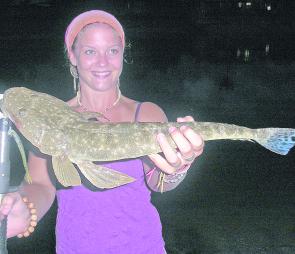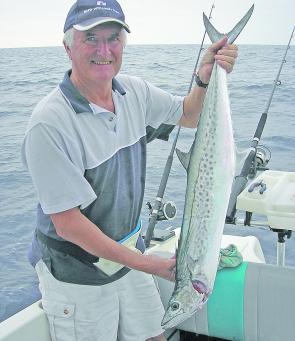Weather permitting it has been an outstanding start to the winter season with many reef species belting lines across the board.
Tell-tale signs of a strong run of snapper, red emperor, Moses perch, pearlies, parrot, hussar and many other species have been reported from the top of the Hards right down to the northern tip of Moreton Island. This is great news for anglers as we come off a fairly average summer run full of all sorts of mishaps.
The best news to come from all this is that boaties do not have to venture too far offshore to get a feed or experience the thump, thump of a big snapper. Murphy’s Reef and the Inner & Outer Gneerings, which are 6km+ and 3-6km respectively out from Mooloolaba Harbour are a great starting point. One of the key issues is that you will need to time and plan your trips carefully to ensure maximum return.
A run to either high or low tide, on the run up to a full or new moon and fishing in the key times of early morning sun rise or late afternoon sunset should put you on the track to start. If you are like me and believe fishing the dark side of the moon is more advantageous then that’s when you should head out.
Once you pick your site and anchor, wait until about 30-45 minutes prior to last light before you start your berley trail. Starting one too early can lead to great losses of bait to the pickers and does not necessarily mean that you will get the fish to your spot quicker. Fish will begin to move just on or before last light and commence the feeding process so don’t start too early and waste your resources.
Have lines out on the bottom and a couple of floating baits down the berley trail, along with another out back of the boat just sitting there in case some huge monster needs a feed. This way you cover bottom, top and mid water and with such a spread your chances will be greatly increased.
Use a mixture of livies and dead baits to determine which bait is attracting the fish. Normally pilchards, squid, yakkas and tuna strips will catch you plenty but there are other baits that do the job equally well. We have all heard it hundreds of times but fresh is best and match the bait to what is around the area.
The Barwon Banks may be further out but it is packed with top spots to target many different species. The southern end is the area known as the Rocks whilst at the middle you will find the Three Sisters and then you move up into the Hards and other out lying areas. Each of these areas account for different species and it is just a matter of running a diary on your trips to work out which is best and at what time.
The 85m line is a great spot to try for trag jew and monster pearlies and is situated some 5km east of the middle. We have landed big kingfish, amberjack, sharks and even cobia in this area all year round.
If that is too deep for your liking there are many areas ranging from 27m-60m around the region. Moving south to Wide Caloundra you will reach an area well known for its pearl perch and big snapper. Live bait is without doubt the best out there and if you can get it fresh squid is an absolute killer on the big snapper, red emperor and coral trout.
The closer 5, 7 and 12 mile reef systems around Caloundra normally produce better catches in the evening, but don’t discount early morning starts. Floaters seem to work the best around the area and your main target is the fighting cobia.
Some days the cobia just swim around the boat and don’t seem to care about anything you throw at them and within a split second all hell can break loose. The lessons here are similar to that of chasing barramundi and other species – patience and have a line in the water when the bite period begins.
Currimundi Reef and Brays Rock are always worth a troll around and many good amberjack, cobia and mackerel have been taken on floating dead baits. Currimundi is also a good spot to look for livies such as yakkas and occasionally a good run of slimies. There are so many options for us when it comes to targeting reefies.
If I could make a request of boat owners it is to please check their all-round white lights and their starboard and port colour lights before heading out. It is amazingly difficult to see most boat lights at the best of times but even more difficult when they are full of dirt and muck and hardly show at all. It is even worth replacing them occasionally if they are not bright.
Remember that big ships move in and out of the waters around Murphys and the Caloundra 5, 7 and 12 mile Reef systems at all times of the day, including night. If the big ships can’t see you, then you are in big trouble. It is not worth losing your life over a light.
The estuaries are slowly changing over to the winter species such as the bigger bream, smaller flathead, winter whiting, queenies and trevally.
Working the structures around the canals and bridges is one of the best solutions for trevally and queenies. Military Jetty is as popular as ever, so too is the sand flats round the channel at Bells Creek. And the Powerboat Club always gets a mention for its whiting. This is due to the many sand and weed banks that are around the club and it’s always handy if you need a burger and cold drink.
The Blue Hole on the eastern side of the Passage running parallel to Bribie Island will be the place to fish for quality bream over the coming months, as will the Boardwalk in Caloundra.
During the low tide it is worth a trip around to the back of Bells Creek close to the boat ramp to pump some live yabbies for use later in the day or the next morning. Fresh yabbies and live worms are killers on the bream and if you know where they live prawns are just awesome.
Plenty of anglers contact me about using their lures for trolling in the canals and channels round Caloundra, Pelican Waters and Maroochydore. This is a great part of fishing these days and as long as you know what species you are targeting then trolling is an effective method of catching those straggler big ones.
I troll my Rapala 12 and 14 X-Raps targeting trevally, mulloway and queenies through the deeper channels of the Pumicestone Passage and lately in the canals around Kawana. Even flathead have taken them whilst slow trolling at around 3-4 knots. The key is really having some local knowledge of the area and understanding when you are about to cross rises in the bottom so that you don’t loose too many lures or soft plastics. Always spend the time surveying the area prior to a major fishing trip as it will pay off.
The beach fishing scene is ready to rocket with the soft seas of winter. The Wurtulla strip from Dickys Beach to Point Cartwright has dart, flathead, bream, tailor and whiting all waiting to take a bait. At least now we do not have to worry about the bluebottles.
Working the rocks off Kings Beach can reward you with tailor, bream and trevally, and along the beach go for whiting and bream. This really is shaping up to be a good winter season so make sure you are a part of it. Get out there and have fun!
Reads: 5468
Coral trout are around the shallow reefs throughout May.

Flathead can be taken in the canals anytime of the year.

The last of the mackerel run before the start of the winter season.




